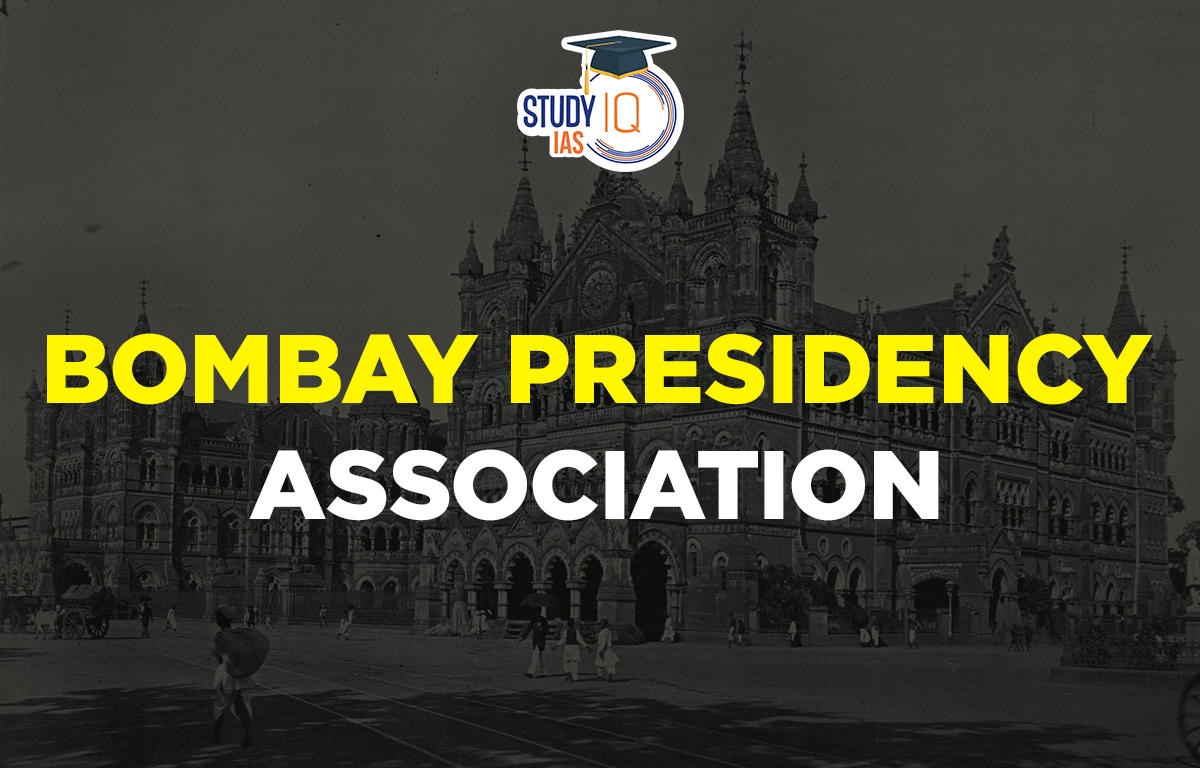Table of Contents
Bombay Presidency Association
Pherozshah Mehta, K.T. Telang, and Badruddin Tyabji founded the Bombay Presidency Society in 1885. It was established in answer to the Ilbert Bill controversy and Lytton’s reactionary policies. The Bombay Presidency or Bombay Province also referred to as Bombay and Sind (1843–1936), was a British Indian administrative division (province) with its capital in Bombay. It was the first mainland territory gained in the Konkan region following the Treaty of Bassein (1802). Mahabaleshwar served as the summertime headquarters. The Bombay Presidency Association will be discussed in this article as it will be useful for UPSC exam preparation.
Read More: Poona Sarvajanik Sabha
Bombay Presidency Association 1885 History
Indian Citizens of Bombay held a public meeting at the Elephantine Institute following the founding of the British Indian Association in Calcutta, where the foundation for the first political organisation in the Bombay Presidency was set. Hindus mixed publicly and freely with people from all walks of life, including Parsees, Jews, and Portuguese people.
The Bombay Association would serve as the people’s representative to the presidency, with a set yearly fee of twenty-five rupees, according to the decision made at the meeting, which was presided over by Jagannath Shankar Sheth. Unexpectedly, a donation of Rs. 30,000 was received to start the organisation. The organisation wanted to “ascertain the wants of the natives of India in the Bombay Presidency,” according to the first resolution.”
Read More: Deccan Riots
Bombay Presidency Association Features
Pherozeshah Mehta, K.T. Telang, and Badurddin Tyabji, three influential Bombay leaders, established the Bombay Presidency Association in January 1885. The organisation and Poona Sarvajanik Sabha have always gotten along well. In order to present India’s cause to the British electorate, the Bombay Presidency Association, the Poona Sarvajanik Sabha, the Madras Mahajana Sabha, and the Indian Association of Calcutta sent a joint deputation to England in September 1885.
- Chandavarkar of Bombay, Ramaswami Mudaliar of Madras, and Manmohan Ghosh of Calcutta served as the delegation’s leaders. Three months later, the Bombay Presidency Association held the first Congress. The trio of Pherozeshah Mehta, Kashinath Telang, and Badruddin Tyabji was referred to as “The Triumvirate” or “The Three Lights” of Bombay’s public life.
Read More: Poligars Revolt
Bombay Presidency Association Founders
1. Pherozeshah Mehta
Sir Pherozeshah Merwanjee Mehta was an Indian Parsi politician and attorney who lived in Mumbai from August 4, 1845 to November 5, 1915. His contributions to the law earned him a knighthood from the British government in India. In 1873, he was appointed Municipal Commissioner of the Bombay Municipality. From 1884 to 1911, he served as President.
Mehta presided over the Indian National Congress in Calcutta in 1890 as its president and a founder member. Mehta was chosen as the first president of the Bombay Presidency Society in 1885, and he held the position for the remainder of his life. In order to improve India, he urged Indians to seek Western education and adopt Western culture. He promoted a number of social issues in the city and across India, such as healthcare, sanitation, and education.
2. Badruddin Tyabji
On October 10, 1844, Tyab Ali, also known as Badruddin Tyabji, was born in Bombay. His father came from a long-established Arab Cambay emigrant household. After passing the London matriculation, he entered the Middle Temple, became a barrister in April 1867, the first Indian barrister in Bombay, and advanced rapidly in his field. After three years practising law, Tyabji made his public début. He was a key player in the effort to establish an elective Bombay Municipal Corporation in July 1871, and he was at the head of the list of those who were later elected to that body.
As a result, the public life of Bombay came to refer to Badruddin Tyabji, Pherozeshah Mehta, and Kashinath Telang as “The Triumvirate” or “The Three Stars” (in that order). He was chosen to serve on the Bombay Legislative Council in 1882, but due to health issues, he withdrew in 1886. In 1885, he assisted in founding the Bombay Presidency Association, which he ran almost completely by himself.
Soon after, with Tyabji and his brother Camruddin Tyabji among its delegates, the Indian National Congress conducted its inaugural meeting in Bombay under its sponsorship. Their opponents took advantage of the fact that their attendance was hindered by pressing business in Cambay to claim that Muslims were skipping the Congress. This was strongly refuted by him, who asserted that he had “denounced all communal and sectarian prejudices.”
3. Kashinath Trimbak Telang
Kashinath Trimbak Telang was a Maratha Brahmin who was born in 1850. He attended a Marathi school for his elementary and secondary schooling. He graduated from Elphinstone College with an M.A. and an L.L.B. In a relatively short span of time, K.T. Telang became a well-known lawyer in Bombay. He was chosen to serve as a justice in the Bombay High Court in 1889.
He became well-known in Hindu law due to his mastery of Sanskrit and English as well as his depth of knowledge of the ancient Hindu texts. He joined the Indian National Congress as soon as it was founded. He was chosen to serve as INC’s inaugural clerk. He was also an activist for social change who promoted women’s education and the advancement of the under classes. He was a well-known figure in the INC’s reasonable wing.
Read More: Ramosi Uprising
Bombay Presidency Association UPSC
The first part of the nineteenth century saw the emergence of political organisations. The well-off and well-educated intelligentsia originally controlled them. The reactionary tactics of Lytton and Ilbert Bill led to the creation of the Bombay Presidency in 1885. In late 1885, the Association held the first gathering of the Indian National Congress in Bombay and promoted Indian interests. Read all information pertaining to the Bombay Presidency Society for the UPSC Exam.
Read More: Bhil Revolt





















 WhatsApp
WhatsApp